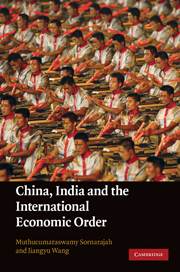Book contents
- Frontmatter
- Contents
- Notes on contributors
- Preface
- Introduction and overview
- PART I China, India and the global trade system
- 1 The WTO and development policy in China and India
- 2 China, India and developing countries in the WTO
- 3 China–India cooperation, South–South coalition and the new international economic order
- 4 India, China and foreign investment
- 5 China, India and WTO Law
- 6 China, India and the WTO dispute settlement system
- 7 China, India and dispute settlement in the WTO and RTAs
- 8 China, India and global outsourcing of services under GATS
- 9 International dispute settlement
- PART II China, India and regional economic integration in Asia
- PART III Law and development in China and India: Domestic issues
- Index
- References
4 - India, China and foreign investment
from PART I - China, India and the global trade system
Published online by Cambridge University Press: 03 May 2011
- Frontmatter
- Contents
- Notes on contributors
- Preface
- Introduction and overview
- PART I China, India and the global trade system
- 1 The WTO and development policy in China and India
- 2 China, India and developing countries in the WTO
- 3 China–India cooperation, South–South coalition and the new international economic order
- 4 India, China and foreign investment
- 5 China, India and WTO Law
- 6 China, India and the WTO dispute settlement system
- 7 China, India and dispute settlement in the WTO and RTAs
- 8 China, India and global outsourcing of services under GATS
- 9 International dispute settlement
- PART II China, India and regional economic integration in Asia
- PART III Law and development in China and India: Domestic issues
- Index
- References
Summary
The announcement of open door policies in Asia have largely applied to foreign investment as they preceded liberalization in the area of trade. China announced its open door policy in 1979 and India set in train less stringent foreign investment controls in 1992. Both events occurred well before the establishment of the World Trade Organization in 1995. To this extent, the developments as to liberalization in the area of foreign investment preceded those in international trade. The move towards free markets showed an ascendancy with the emergence of Thatcherism and Reagonomics and the fall of the Soviet Union, which removed a powerful competing model from the scene. Many factors at the time favoured liberalization of the foreign investment regime. The loans crisis arising from the circulation of petro-dollars had led to the drying up of private funds. Aid had become non existent. The states of Eastern Europe, released from Soviet hold and adopting free market economics, increased competition for the only means of private capital, the investments of multinational corporations. The situation was ripe for liberalization on a global scale. But, though individual countries did show fervour for the adoption of the liberalization model in their foreign investment policies, at the global level, the trend towards globalization has not resulted in global rules on foreign investment. With economic crises in Asia, Russia and Argentina, there has been some rethinking on the value of liberalization of foreign investment regimes.
- Type
- Chapter
- Information
- China, India and the International Economic Order , pp. 132 - 166Publisher: Cambridge University PressPrint publication year: 2010
References
- 3
- Cited by

